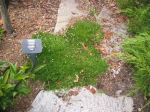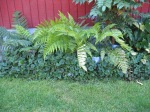Corsican Mint/Mentha requienii
I love this little mint. It’s one of the tiniest and most delightful plants in our garden. It’s probably the smallest mint you can grow, and only gets a couple of inches tall, but it spreads indefinitely. It’s so wonderful to rub your fingers over it and inhale its sweet fresh scent. I’ll show you several places it’s growing, both where I planted it and where it decided to grow on its own. It’s all over the place now, and I didn’t plant a lot of it. I’ve never seen a flower or seed on it, but somehow it manages to jump all over and grows in the oddest places, often far from the main plants. (Ed. note – Boy I thought I was more observant than this – I just saw dozens of little blue flowers all over these beauties. Must be where the seeds come from. Duh…) Interesting and wonderful!
I first planted a 2” pot of it here among the stones of the walk to the bird feeder in 2008. I’ve had to replant it a few times over the years because it tends to die back in winter, but not always completely. It still persists in coming up and spreading on its own, even when I don’t replant it. This photo is from 2016, and it’s still there today, as you can see in the next photo.
Most of this patch spread from the plants growing among the stones of the walkway, tho I planted a bit under the maple as well. This is the largest patch of it we have, and it’s been steadily expanding over the last several years. Bits of this clump have also jumped across the lawn to grow on the other side. How it does that I haven’t a clue!
These are the stepping stones that lead to the path along the north side of the house from the front to the back. I planted a dozen little 2” pots all among them in May, 2016. You can see how well they filled in over the next few months in the next couple of photos.
This is in June, after only a month of growth. It grew quite fast, probably because I mulched it well and watered it so often!
Sorry this one is so shady, but it’s the only photo I had of it at this stage. This was taken in September of the same year. It was totally full and lush and it was a delight to walk thru it on the stone path. It’s lovely when the smell wafts up to your nose as you bruise it. It won’t take walking on directly, but if you just brush gently against it it doesn’t hurt it. It looked so gorgeous. I had high hopes that it would be there forever after such an impressive start, but it died down almost completely over the following winter. Darn…
This is what that area looks like today. I haven’t planted any more of it since 2016, but somehow little pieces of it managed to stay alive and it’s now spread around the space. It has a nice naturalistic look to it that I find very attractive. I like the little “wild” areas we have here and there in the garden. They give it a cool energy.
This is an example of how this marvelous mint jumps from one place to another all on its own. The main clump has been here for about 4 or 5 years but the little spots coming up along the lawn edge have all developed and grown this year. As I’ve mentioned I don’t have a clue as to how it does this. It obviously puts on seeds of some sort, but I’ve never seen any of them, or any flowers to give rise to them either. Oh well, I think it’s a wonderful plant mystery, so I just enjoy it.
Here’s another example of this mint jumping around. I planted a small pot of it near the gate here in 2008, very early on in the history of this garden. Later on I planted some by the purple beech too. It mostly died out where I put it but now it’s coming up in the cracks of the pavement! The seeds must be very tiny to do that. But how do they get there? Who cares? I’m in thrall to this plant – it’s so magical!
These last photos are of small 2” pots I planted in February of this year. You can see how big they’ve grown in just 4 months. Lots of water, mulch and loving care, and tons of appreciation. I give all our plants a lot of appreciation. I think they thrive on it, but maybe I’m just pretending to hear their joy when I tell them how beautiful they are. Whatever – they sure do grow well!
OK, that’s the story of the Corsican Mint, from my perspective anyway. I assume you’ve guessed that it comes from Corsica, and the Mediterranean in general. Lots of our common culinary herbs come from that region of the world. I’ve never been there but I think I’d enjoy the plants that grow there very much. The hot dry climate is similar to where I grew up in central California. Herbs, and fruits like grapes and olives, do well in both locations. Of course we’re growing this mint in Seattle, and it does just fine here, as you’ve seen. It will probably grow well your garden too. Give it a try!
Fragrantly yours,
Steve













































































































































